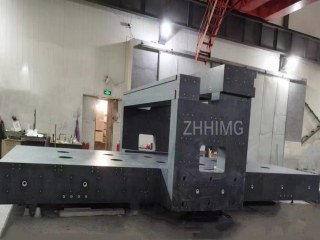In the field of semiconductor manufacturing, the accuracy of wafer inspection equipment directly determines the quality and yield of chips. As the foundation supporting the core detection components, the dimensional stability of the equipment base material plays a crucial role in the long-term operational performance of the equipment. Granite and cast iron are two commonly used base materials for wafer inspection equipment. A 10-year comparative study has revealed the significant differences between them in terms of dimensional stability, providing important references for equipment selection.
Experimental Background and Design
The production process of semiconductor wafers has extremely high requirements for detection accuracy. Even a micrometer-level dimensional deviation can lead to a decline in chip performance or even scrapping. To explore the dimensional stability of granite and cast iron during long-term use, the research team designed experiments that simulated real working environments. Granite and cast iron samples of the same specification were selected and placed in an environmental chamber where the temperature fluctuated from 15℃ to 35℃ and the humidity fluctuated from 30% to 70% RH. The mechanical vibration during the operation of the equipment was simulated through a vibration table. The key dimensions of the samples were measured every quarter using a high-precision laser interferometer, and the data were continuously recorded for 10 years.

Experimental result: The absolute advantage of granite
Ten years of experimental data show that the granite substrate exhibits astonishing stability. Its coefficient of thermal expansion is extremely low, averaging only 4.6×10⁻⁶/℃. Under drastic temperature changes, the dimensional deviation is always controlled within ±0.001mm. In the face of humidity changes, the dense structure of granite makes it almost unaffected, and no measurable dimensional changes occur. In a mechanical vibration environment, the excellent damping characteristics of granite effectively absorb vibration energy, and the dimensional fluctuation is extremely small.
In contrast, for the cast iron substrate, its average coefficient of thermal expansion reaches 11×10⁻⁶/℃ - 13×10⁻⁶/℃, and the maximum dimensional deviation caused by temperature changes within 10 years is ±0.05mm. In a humid environment, cast iron is prone to rust and corrosion. Some samples show local deformation, and the dimensional deviation further increases. Under the action of mechanical vibration, cast iron has poor vibration damping performance and its size fluctuates frequently, making it difficult to meet the high-precision requirements of wafer inspection.
The essential reason for the difference in stability
Granite was formed over hundreds of millions of years through geological processes. Its internal structure is dense and uniform, and the mineral crystals are stably arranged, eliminating internal stress by nature. This makes it extremely insensitive to changes in external factors such as temperature, humidity and vibration. Cast iron is made by casting process and has microscopic defects such as pores and sand holes inside. Meanwhile, the residual stress generated during the casting process is prone to cause dimensional changes under the stimulation of the external environment. The metallic properties of cast iron make it prone to rusting due to humidity, accelerating structural damage and reducing dimensional stability.
The impact on wafer inspection equipment
Wafer inspection equipment based on granite substrate, with its stable dimensional performance, can ensure that the inspection system maintains high precision for a long time, reduce misjudgment and missed detection caused by equipment accuracy drift, and significantly improve product yield. Meanwhile, the low maintenance requirements reduce the full life cycle cost of the equipment. Equipment using cast iron substrates, due to poor dimensional stability, requires frequent calibration and maintenance. This not only increases operating costs but also may affect the quality of semiconductor production due to insufficient precision, causing potential economic losses.
Under the trend of the semiconductor industry's pursuit of higher precision and better quality, choosing granite as the base material for wafer inspection equipment is undoubtedly a wise move to ensure equipment performance and enhance the competitiveness of enterprises.
Post time: May-14-2025

